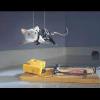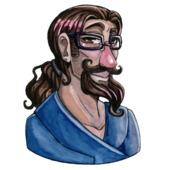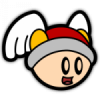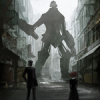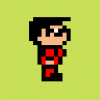What is the best 2D art program?
Which program is the easiest to learn to use? Which program makes it a little easier to make graphics/tiles/sprites etc.? Price is no object to me. I've heard Paint Shop Pro 7 is good(I'm sure someones selling a copy on ebay).
In my opinion, it really doesn't matter which program you use because it will all come down to how skilled you are. Some programs have other filters and whatnot. I like to use Photoshop a lot, but I don't mind using gimp if I am not at home.
Thanks for your input. I'll get the trials for the programs im thinking about getting.
I recommend Photoshop. It is hands down the most complete raster art program out there.
Some may say it doesn't matter, and it comes down to skill, like monp, here. However, Photoshop has the performance and extra features that make it a lot better than others. That, and it also comes down to usability, the better the usability the better the work flow efficiency will be, and Photoshop is very good at usability (a major problem with Gimp, imo). You don't have to get the version with all the bells and whistles, but avoid photoshop essentials and go for the full version.
Though, for pixel art, it almost doesn't matter which app you use, as you're just using the basics of it.
Some may say it doesn't matter, and it comes down to skill, like monp, here. However, Photoshop has the performance and extra features that make it a lot better than others. That, and it also comes down to usability, the better the usability the better the work flow efficiency will be, and Photoshop is very good at usability (a major problem with Gimp, imo). You don't have to get the version with all the bells and whistles, but avoid photoshop essentials and go for the full version.
Though, for pixel art, it almost doesn't matter which app you use, as you're just using the basics of it.
-------------------------Only a fool claims himself an expert
Photoshop is the most common/standard 2D art program used in the game industry.
[size=2]Darwinbots - [size=2]Artificial life simulation
If you are looking for free applications, Paint.NET looks nice. You need the .NET runtime for it though. People seem to like GIMP as well.
Personally, I use MSPaint for the basic outlines and coloring, and PaintShop Pro XI (Previously I used PSP8) for its effects, filters, and texturing capabilities to finish off the image. PaintShopPro costs about $70 though. (They just released PSP12)
I really love Paint Shop Pro. I'm more of a programmer than a artist, however. I've never tried Photoshop.
Personally, I use MSPaint for the basic outlines and coloring, and PaintShop Pro XI (Previously I used PSP8) for its effects, filters, and texturing capabilities to finish off the image. PaintShopPro costs about $70 though. (They just released PSP12)
I really love Paint Shop Pro. I'm more of a programmer than a artist, however. I've never tried Photoshop.
Quote: Original post by JaxDragon
Which program is the easiest to learn to use? Which program makes it a little easier to make graphics/tiles/sprites etc.? Price is no object to me. I've heard Paint Shop Pro 7 is good(I'm sure someones selling a copy on ebay).
Which is best and easiest to use depends a lot on what you want to do and what prior experience you have. There's a lot of decent tools out there ranging in power and price. Sometimes the software with all the bells and whistles isn't the best for a particular person, if said bells and whistles only acts a distraction from what they need to do.
First off: there's two different types of graphics editors out there, raster and vector. And sometimes tools that work with both, but usually tools are better with one or the other. Raster works on editing bitmaps directly; your image is represented as a big square grid of pixels. Vector works by editing geometric shapes, paths and nodes. Both are useful for different things.
Adobe's products are the most used professionally these days. Photoshop is used for raster graphics, Illustrator for vector. Fireworks and Flash are used as well. The downside is that they're pricey, and (in my opinion) they've got a steeper learning curve to use properly. Also depending on what you want to do you mightn't need the power of Photoshop.
In free software, GIMP is the most commonly used raster graphics editor, and Inkscape is popular for vector art. Both of these aren't as powerful as Adobe's tools, but they're more than capable of making good art. However in my opinion the GIMPs interface is pants. I found Inkscape remarkably easy to use though, and I really recommend trying it out to anyone who wants to try a vector editor. I prefer Inkscape's interface to Illustrator actually, although that may be because I've had more practice with it.
Then there's a bunch of other tools out there that offer different incentives in price, performance and/or usability categories. Unfortunately I haven't tried many of these out myself, so I'll have to leave it to others to tell you about them, or for you to hunt down their demos.
I use myself mainly Fireworks, and sometimes Inkscape.
I plainly love Fireworks, it is easy to use, with a well organize interface, and I can mix vector and raster graphics at will, making some things really easy to do.
Also I hate photoshop and gimp, to me both are just some bloated pieces of software that are hell annoying to use, the only use of photoshop to me is some funky features (like a seamless texture generator based on a photo) that he have and that I used once or twice, but they do not make the program worthy to be bought (I used the program on the computer of someone else, when I needed)
Currently Fireworks suit all my needs, ranging from sprite creation, spritesheet creation using pre-rendered frames, vector illustrations, logos, web-site needs (this is where fireworks really shine) and even composition.
Also people usually like photoshop filters, if you have fireworks and photoshop installed, you can make fireworks use photoshop filters (not all them, some are too bizarre and are not supported), also the fireworks filter system does not change the image, it create a "stack" of filters, that you can edit and change at will, re-order, and save and reload (something really usefull when you find how to generate somethign with a filter, like a plaster texture)
Also fireworks works well with dithering, and I think that this is really usefull, specially to simulate 50% transparency without actual transparency (transparency on some systems is SLOOOOOOOOOW)
I plainly love Fireworks, it is easy to use, with a well organize interface, and I can mix vector and raster graphics at will, making some things really easy to do.
Also I hate photoshop and gimp, to me both are just some bloated pieces of software that are hell annoying to use, the only use of photoshop to me is some funky features (like a seamless texture generator based on a photo) that he have and that I used once or twice, but they do not make the program worthy to be bought (I used the program on the computer of someone else, when I needed)
Currently Fireworks suit all my needs, ranging from sprite creation, spritesheet creation using pre-rendered frames, vector illustrations, logos, web-site needs (this is where fireworks really shine) and even composition.
Also people usually like photoshop filters, if you have fireworks and photoshop installed, you can make fireworks use photoshop filters (not all them, some are too bizarre and are not supported), also the fireworks filter system does not change the image, it create a "stack" of filters, that you can edit and change at will, re-order, and save and reload (something really usefull when you find how to generate somethign with a filter, like a plaster texture)
Also fireworks works well with dithering, and I think that this is really usefull, specially to simulate 50% transparency without actual transparency (transparency on some systems is SLOOOOOOOOOW)
IGDA São Paulo member.Game Design student.
Quote: Original post by Speeder
...also the fireworks filter system does not change the image, it create a "stack" of filters, that you can edit and change at will, re-order, and save and reload (something really usefull when you find how to generate somethign with a filter, like a plaster texture)
You are aware that even aging versions of Photoshop have this feature, too? I believe CS 1, 2, and 3 do it that way.
Quote: Also fireworks works well with dithering, and I think that this is really usefull, specially to simulate 50% transparency without actual transparency (transparency on some systems is SLOOOOOOOOOW)
What systems are you using? I can only imagine that transparency would be slow when doing software rendering. If you use OpenGL or DirectX on even vaguely modern hardware, transparency will be very nearly free. Unless, of course, you're referring to mobile devices or something else similar.
I'm working on a more painterly 2D approach, so for my purposes the best packages are Autodesk Sketchbook Pro, Adobe Photoshop and Corel Painter. I've never actually used Painter, so I have no comment on it - I'll give a demo a trial in a couple weeks. Sketchbook Pro I love because of its genuinely tablet-centric interface; it's the only application I know of where you can really do most things without interrupting your pen work to use the keyboard. I mean, its layer interface lets you write and erase names (or arbitrary glyphs and symbols, if you wish) for your layers using the pen.
Photoshop is an industry standard, so if you intend to work as a professional in a workflow involving others, you'll need to learn it. (Conversely, if you intend to work as a freelancer who only delivers proofs and finals to clients, you can skimp on the Photshop; delivering PSD or PDF is the most you'll need.) Photoshop is also a powerful drawing and painting tool - its brush engine is perhaps the most powerful I've seen or heard of.
Ultimately, JaxDragon, it comes down to what you're trying to accomplish and how you prefer to work. All of these apps provide free trials now, so download them and give each one a whirl. None of them is automatically going to make your work brilliant, or even better - it's still up to you to gain the core skills that will make you a good artist.
Good luck! [smile]
Photoshop is an industry standard, so if you intend to work as a professional in a workflow involving others, you'll need to learn it. (Conversely, if you intend to work as a freelancer who only delivers proofs and finals to clients, you can skimp on the Photshop; delivering PSD or PDF is the most you'll need.) Photoshop is also a powerful drawing and painting tool - its brush engine is perhaps the most powerful I've seen or heard of.
Ultimately, JaxDragon, it comes down to what you're trying to accomplish and how you prefer to work. All of these apps provide free trials now, so download them and give each one a whirl. None of them is automatically going to make your work brilliant, or even better - it's still up to you to gain the core skills that will make you a good artist.
Good luck! [smile]
This topic is closed to new replies.
Advertisement
Popular Topics
Advertisement
Recommended Tutorials
Advertisement



